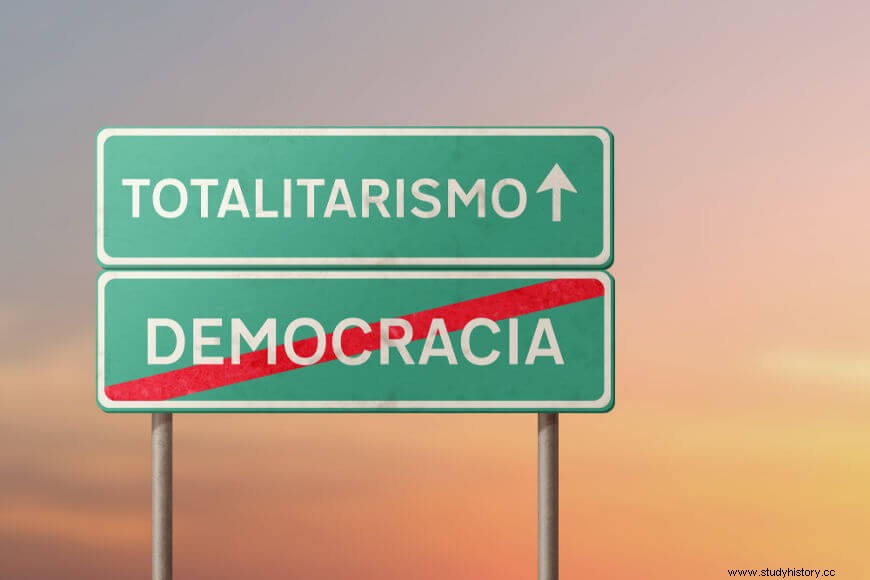
totalitarianism It is a political system characterized by the absolute rule of a person or political party over a nation. Within totalitarianism, the person or political party in power controls all aspects of public and private life through an overtly authoritarian government.
Totalitarianism is also marked by a strong presence of a militarism in society and is accompanied by actions by the regime with the aim of promoting its ideology through a system of indoctrination of the population. Totalitarian regimes use terror as a political weapon to contain and persecute their political opponents, and political propaganda is used consistently so that the population is convinced of the extreme measures taken by these regimes.
Totalitarianism was a political system that was at its height during the1920s and 1930. Its emergence took place after the First World War and is considered by historians as a reflection caused by all the destruction caused by that conflict. Thus, authoritarianism began to gain strength as a political solution for the crises that the world was facing in the post-war period, gaining supporters around the world.
The rise of authoritarianism marked the fall of the values of liberalism, which are defined as follows by historian Eric Hobsbawm:
These values were distrust of dictatorship and absolute government; the commitment to a constitutional government with or under freely elected representative governments and assemblies, which would guarantee the rule of law; and an accepted set of rights and freedoms for citizens, including freedom of expression, publication and assembly.|1|
The term “totalitarianism” emerged during the 1920s to refer to Italian fascism. This political system even emerged with Italian fascism itself, a regime that came to power in Italy in 1922, when Mussolini became the country's prime minister. Throughout the 1920s, the world political trend was toward authoritarianism, and totalitarianism gained considerable strength after the rise of Nazism to power in Germany.
Also see: Discover the history of Salazarism, an authoritarian regime that was influenced by fascism
Characteristics of totalitarian regimes
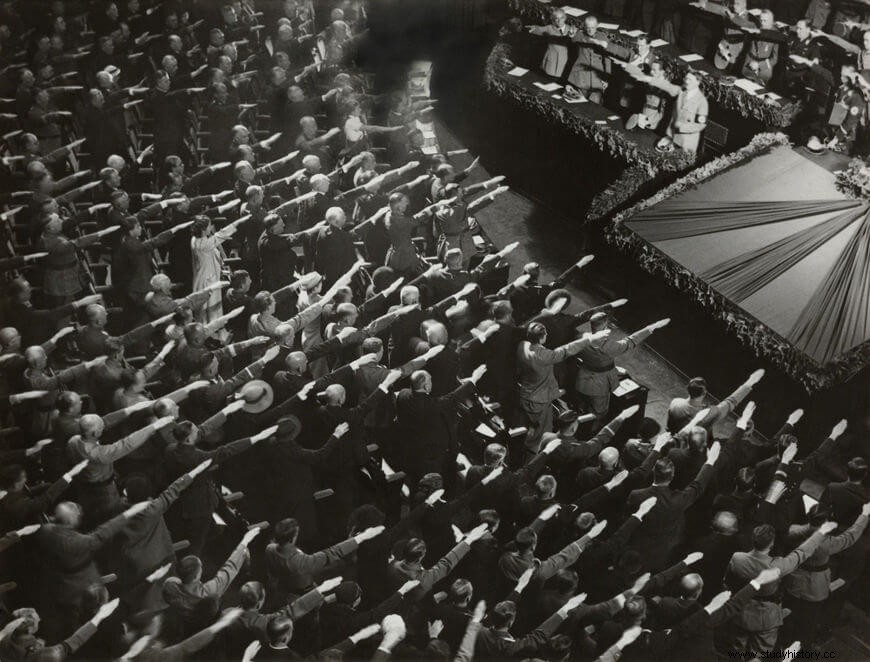
Germans performing the Nazi "Heil Hitler" salute. The cult of the leader is one of the characteristics of totalitarian regimes.*
The consensus among historians determines that the basic characteristics of totalitarianism are inspired by three regimes:fascism, Nazism and Stalinism . There is intense debate among these professionals about whether other regimes, such as the Khmer Rouge in Cambodia and the current North Korean regime, fit within the concept of totalitarianism. Despite this debate, in this text we will only consider Nazism, Fascism and Stalinism .
The basic characteristics of totalitarianism are:
-
Leadership :The three regimes had a strong cult of the leader, and his image was spread in all possible places, like schools, for example.
-
One-Party :All totalitarianisms suppressed the existence of parties, and only the ruling party was allowed to function.
-
Indoctrination :The population of totalitarian regimes was the target of intense indoctrination, which began with early childhood education. This indoctrination was intended to propagate the government's ideology.
-
Centralization of power :Political power in totalitarianism is centralized in the leader and/or in the party.
-
Use of terror :Terror was a weapon used by totalitarian regimes to frighten their opponents and persecute groups seen as “enemies of the State”.
-
Censorship :Censorship was a common practice for newspapers and the general population. Totalitarian regimes did not accept criticism, denunciations and did not put up with the existence of an opposition.
-
Military :Exaltation of the army and militarization of society.
-
Creating internal and/or external enemies :This mechanism was used as a distraction or justification to explain the regime's actions and authoritarianism.
-
Nationalism Exacerbated :Nationalism in totalitarianism assumed an extremist bias that preached the exclusion and persecution of other peoples or ethnicities.
Totalitarian regimes in Europe
As mentioned, we will highlight in this text the main totalitarian experiences that existed in Europe during the interwar period. On the far right on the political spectrum are Italian fascism and German Nazism, and on the far-left , is Soviet Stalinism.
-
Nazism
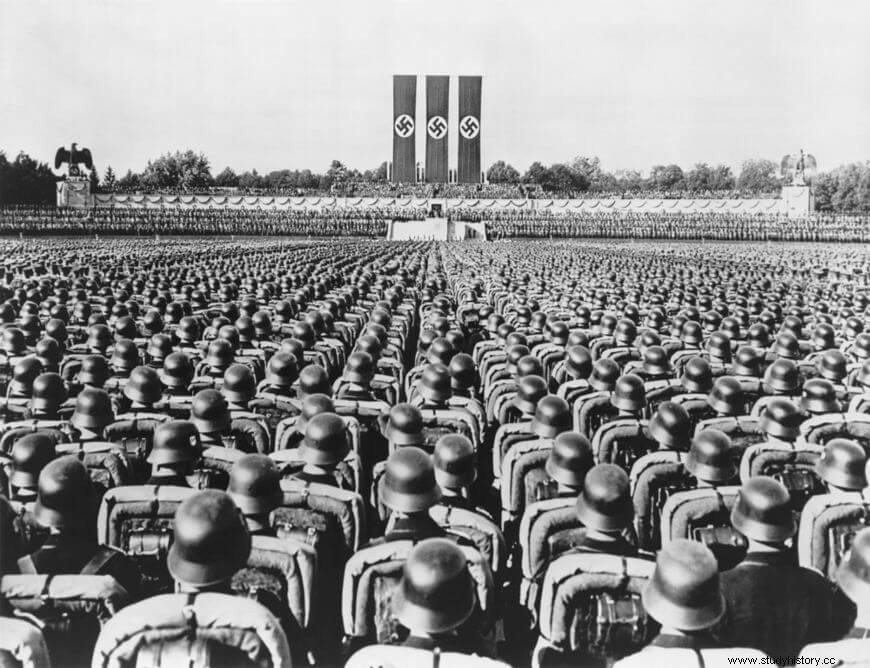
The Nazi Party emerged in Germany in 1919 and took power in the country in 1933, when Hitler was appointed German Prime Minister.*
Nazism emerged in Germany, with the name of National Socialist German Workers' Party , in 1919. The great leader of the party was Adolf Hitler , Austrian appointed Prime Minister of Germany in 1933. The growth of the Nazi Party in Germany was a result of the crisis that set in the country after the First World War and the Great Depression.
The Nazis organized storm troopers (SA) that acted to intimidate the party's opponents, mainly the Social Democrats and Communists. The ideology of Nazism was articulated by Hitler in a book called My Struggle (Mein Kampf , in German), written during the period in which he was imprisoned.
Also read :Adolf Hitler - Biography, Political Trajectory and Main Actions
Nazi ideology incorporated elements such as anti-Semitism , that is, the hatred of Jews that was manifested during the Holocaust, genocide responsible for the deaths of approximately six million of Jews. In addition to anti-Semitism, other characteristics of Nazism were extreme nationalism and racism that gave rise to the idea of Germans as a “pure” and “superior” race (called “Aryans” by the Nazis). Nazism also incorporated anti-Marxism , anti-liberalism , the militarism , a exaltation of war etc.
Nazism ruled Germany from 1933 to 1945, during which time it led that country to war. At that moment, a real dictatorship was installed, and Hitler prepared his country, which had been defeated in the First World War, for a war against the European powers that had participated in the previous combat and won Germany. Throughout the 1930s, the latter country flouted the terms of the Treaty of Versailles and expanded its territory across Europe. To learn more about Nazism, read:Nazism:context, characteristics and consequences.
-
Fascism
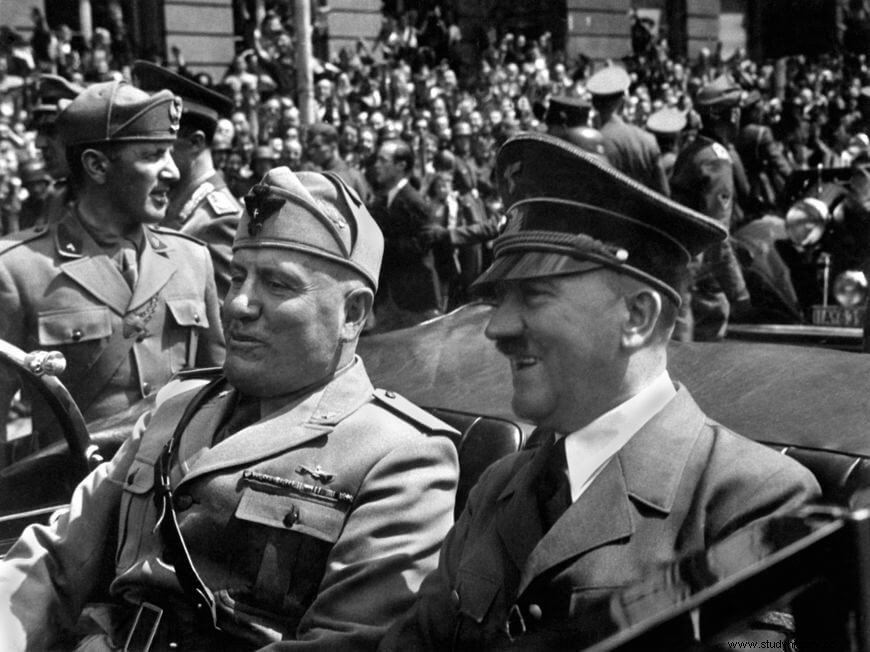
Benito Mussolini and Adolf Hitler, leaders of fascism and Nazism, respectively.*
Fascism emerged in Italy in 1919, when Benito Mussolini created the Fasci Italiani di Combattimento , a group that later became National Fascist Party . The rise of fascism to power in Italy took place in 1922, when the March on Rome was organized.
During this event, thousands of fascists from all over Italy marched towards Rome, the country's capital, to pressure King Victor Emmanuel III to name Benito Mussolini as first -Italian minister. Mussolini's appointment took place and, in 1925, the Italian prime minister proclaimed himself dictator of Italy.
Italian fascism is considered the precursor of Nazism in Germany and, because of this, there are numerous similarities between these two totalitarian strands. Among the characteristics of Italian fascism are:
-
Antiliberalism;
-
Imposition of a one-party system in the country;
-
Contempt for Marxism;
-
Exaltation of traditional values;
-
Negation of modern values;
-
Total control of the state over the economy, politics and culture.
Fascism ruled Italy from 1922 to 1945 and, during the interwar period, allied with Germany. When World War II began in 1939, Italians and Germans were part of the Axis , group that fought against the Allies . To learn more about fascism, read:Fascism – historical context and characteristics.
Also see: Life trajectory of Francisco Franco, leader of a dictatorship in Spain
-
Stalinism
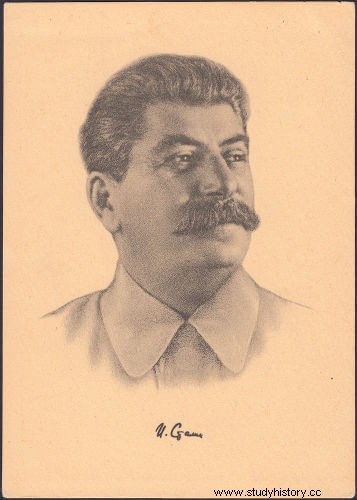
Josef Stalin was leader of the Soviet Union between 1924 and 1953.**
Stalinism is used to refer to the period when the Soviet Union was ruled by Josef Stalin . The application of the notion of totalitarianism to Stalinism is also the subject of debate, as historians such as Eric Hobsbawm|2| , claim that this was not a totalitarian regime, while others, such as Hannah Arendt|3| and Timothy Snyder|4| |5| , claim the opposite.
Josef Stalin assumed power in the Soviet Union shortly after the death of Vladimir Lenin in 1924, but the starting point for Stalinism is considered to be the year 1929 , at which point Stalin became supreme leader of the Soviet Union. He remained in power in a tyrannical manner until 1953 , when he ended up passing away.
Stalin's government is understood as the totalitarian experience of the extreme left and was marked by persecution by opponents , purges , crisis from hunger etc. Among the characteristics of Stalinism are:
-
Exclusion of religion from public life;
-
Collectivization of the economy;
-
End of private ownership;
-
Censorship;
-
One-partyism;
-
Centralization of power;
-
Persecution of opponents;
-
Militarization of society etc.
Throughout the years it was in power, Stalin's government was responsible for the execution of thousands of people seen as enemies of the state. In addition, millions of people were sent to gulags — forced labor camps — and millions also died of starvation during the land collectivization process that took place in the 1930s.
Totalitarian regimes in Brazil
In Brazil there was no totalitarian government, but there were authoritarian governments . Among the authoritarian governments that were in power in our country are the Estado Novo , which took place between 1937 and 1945, and the Military Dictatorship , which took place between 1964 and 1985. Both periods were marked by the absence of individual freedoms, censorship , chase , torture , execution of opponents etc.
Also read: The 1964 military coup
|1| HOBSBAWM, Eric. Age of Extremes:the brief 20th century 1914-1991. São Paulo:Companhia das Letras, 1995, p. 113.
|2| HOBSBAWM, Eric. Age of Extremes:the brief 20th century 1914-1991. São Paulo:Companhia das Letras, 1995.
|3| ARENDT, Hannah. Origins of Totalitarianism. São Paulo:Companhia das Letras, 2012.
|4| SNYDER, Timothy. Lands of Blood:Europe between Hitler and Stalin. Rio de Janeiro:Record, 2012.
|5| SNYDER, Timothy. On Tyranny:Twenty Lessons from the Twentieth Century to the Present. Companhia das Letras:São Paulo, 2017.
*Image credit:Everett Historical and Shutterstock
**Image Credit:Bissig and Shutterstock
